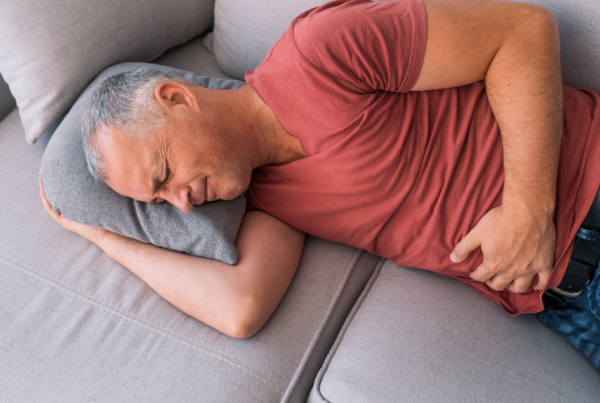Frequent UTIs
Move Better. Live Fuller. Your Wellness Journey Starts Here.
Schedule a FREE Discovery Call!
What Is a Urinary Tract Infection?
A urinary tract infection, or UTI, is an infection of any part of the urinary system—including the bladder, kidneys, ureters, or urethra. It is a common infection that can occur to any individual regardless of their sex. Although it is a common infection, leaving it untreated can create worse complications and other conditions.
This infection causes inflammation in some parts of the urinary system, which creates symptoms like pain with urination, frequent urination, and pain in the sides or lower back. Some other symptoms of urinary tract infections include:
- Urgency
- Urge incontinence
- Cloudy or bloody urine
- Strong smelling urine
- Pelvic pain
- Abdominal pain
- Genital pain
- Burning during urination
- Fever, chills, fatigue

What Causes UTIs?
Put simply, urinary tract infections are created when bacteria enters your urinary system. This happens through the urethra, but can spread to other parts of the system such as your kidneys. The most common cause of UTI is due to a bacteria called E. Coli. The large intestine has this bacteria, which is also present in feces. Therefore, UTIs are more likely to occur for people with a vagina, because of the short distance between the urethral opening and the anus.
Although E. Coli is a very common cause of UTIs, it is not the only cause. Other bacteria can cause UTIs, and bacteria can enter the urinary tract in a variety of ways. Some other factors that cause or increase the likelihood of urinary tract infections include:
- Bacteria transferred from fingers during trips to the bathroom or sexual activities (masturbation, sexual aids)
- Bacteria transferred during sex
- Menopause, birth control, and other medications
- Urinary tract blockages, such as kidney stones
- Exams or surgeries
- Use of a catheter
- Bad bathroom habits
- Pelvic floor dysfunction
As listed above, pelvic floor dysfunction can be a cause of UTIs. The pelvic floor is a group of muscles that support many organs of your body (including the bladder) and are what allow you to urinate or have bowel movements. It plays an essential role in urination, but in cases where an individual has pelvic floor dysfunction, successful or complete urination can be more difficult. Pelvic floor dysfunction is a much more common condition than people realize, and often goes unchecked.
Each person’s pelvic floor dysfunction can vary and may affect them differently. Your pelvic floor physical therapist will be able to examine your pelvic floor function and determine what plan of care is best for you! In general, pelvic floor dysfunction is caused by uncoordinated, tight, short, or weak pelvic floor muscles. This can affect your bladder health, urination, or bathroom habits in ways that may create UTIs. Let’s take a look at some examples!
Pelvic floor dysfunction can cause individuals of any sex to have dysfunctional voiding. Dysfunctional voiding can describe a range of symptoms. In many cases, it can mean that when you urinate, your pelvic floor muscles activate (contract) instead of relax, making it difficult to empty your bladder completely. This is a condition that can cause a higher likelihood of UTIs. A pelvic floor physical therapist can help you learn to coordinate your muscles so that they can properly contract and relax during urination.
In other cases, pelvic floor dysfunction can affect your ability to urinate normally, creating symptoms similar to a UTI—without an infection necessarily being present. When the pelvic floor muscles are short, tight, and inflexible, this can affect the ability of urine to flow properly through the urethra. In some cases, urine can get stuck there and create infection. In other cases, it may not necessarily create infection but give a false impression of one—frequent urination, urgency, and even pelvic pain. If you experience symptoms of a UTI, but receive negative tests, you likely are experiencing pelvic floor dysfunction!
Similarly, having an overly tight pelvic floor can shorten the openings of your urethra (as well as the anus and vaginal opening). This shortening and constriction of the urethra can create symptoms that may mimic UTIs—such as difficulty emptying the bladder completely, resulting in frequent urination. Luckily, pelvic floor physical therapy can be very helpful in teaching you how to coordinate and relax your pelvic floor muscles so that they can function optimally.
Physical Therapy for UTIs
As you may have gathered from the previous section, pelvic floor physical therapy can be a beneficial treatment option—especially for those who are more prone to recurrent UTIs. The type of treatment plan your physical therapist creates for you will depend on your needs and pelvic floor health. Treatment primarily focuses on improving coordination and function of the pelvic floor, as described in the examples above.
Techniques or treatment methods to achieve this will often include biofeedback, manual therapy, exercise prescription, and more. Because UTIs are commonly created by tight or uncoordinated pelvic floor muscles, your physical therapist may teach you relaxation techniques such as diaphragmatic breathing. This helps relax the whole body, including the pelvic floor muscles!
Physical therapists can also incorporate behavioral modifications to your treatment plan, which can help you improve your bathroom habits. The frequency of your urination, posture on the toilet, and many other bathroom habits can affect your pelvic floor and bladder health. Even just holding in your urine for too long can be a cause of urinary tract infections, so it can be helpful to receive guidance from a professional who knows what’s best for your pelvic floor health.
Our physical therapists at Hive Therapy and Wellness are very experienced with urinary tract infections. They are skilled in helping patients optimize their pelvic floor health and lessen their UTI troubles. Each and every patient receives an individualized and unique plan of care that is catered to their needs! You can get started by booking a discovery call, or learning more about our physical therapists first.
A urinary tract infection, or UTI, is an infection of any part of the urinary system—including the bladder, kidneys, ureters, or urethra. It is a common infection that can occur to any individual regardless of their sex.
Although it is a common infection, leaving it untreated can create worse complications and other conditions.
This infection causes inflammation in some parts of the urinary system, which creates symptoms like pain with urination, frequent urination, and pain in the sides or lower back. Some other symptoms of urinary tract infections include:
- Urgency
- Urge incontinence
- Cloudy or bloody urine
- Strong smelling urine
- Pelvic pain
- Abdominal pain
- Genital pain
- Burning during urination
- Fever, chills, fatigue
Put simply, urinary tract infections are created when bacteria enters your urinary system. This happens through the urethra, but can spread to other parts of the system such as your kidneys.
The most common cause of UTI is due to a bacteria called E. Coli. The large intestine has this bacteria, which is also present in feces.
Therefore, UTIs are more likely to occur for people with a vagina, because of the short distance between the urethral opening and the anus.
Although E. Coli is a very common cause of UTIs, it is not the only cause. Other bacteria can cause UTIs, and bacteria can enter the urinary tract in a variety of ways. Some other factors that cause or increase the likelihood of urinary tract infections include:
- Bacteria transferred from fingers during trips to the bathroom or sexual activities (masturbation, sexual aids)
- Bacteria transferred during sex
- Menopause, birth control, and other medications
- Urinary tract blockages, such as kidney stones
- Exams or surgeries
- Use of a catheter
- Bad bathroom habits
- Pelvic floor dysfunction
As listed above, pelvic floor dysfunction can be a cause of UTIs. The pelvic floor is a group of muscles that support many organs of your body (including the bladder) and are what allow you to urinate or have bowel movements.
It plays an essential role in urination, but in cases where an individual has pelvic floor dysfunction, successful or complete urination can be more difficult.
Pelvic floor dysfunction is a much more common condition than people realize, and often goes unchecked.
Each person’s pelvic floor dysfunction can vary and may affect them differently. Your pelvic floor physical therapist will be able to examine your pelvic floor function and determine what plan of care is best for you!
In general, pelvic floor dysfunction is caused by uncoordinated, tight, short, or weak pelvic floor muscles. This can affect your bladder health, urination, or bathroom habits in ways that may create UTIs. Let’s take a look at some examples!
Pelvic floor dysfunction can cause individuals of any sex to have dysfunctional voiding. Dysfunctional voiding can describe a range of symptoms.
In many cases, it can mean that when you urinate, your pelvic floor muscles activate (contract) instead of relax, making it difficult to empty your bladder completely.
This is a condition that can cause a higher likelihood of UTIs. A pelvic floor physical therapist can help you learn to coordinate your muscles so that they can properly contract and relax during urination.
In other cases, pelvic floor dysfunction can affect your ability to urinate normally, creating symptoms similar to a UTI—without an infection necessarily being present.
When the pelvic floor muscles are short, tight, and inflexible, this can affect the ability of urine to flow properly through the urethra.
In some cases, urine can get stuck there and create infection. In other cases, it may not necessarily create infection but give a false impression of one—frequent urination, urgency, and even pelvic pain.
If you experience symptoms of a UTI, but receive negative tests, you likely are experiencing pelvic floor dysfunction!
Similarly, having an overly tight pelvic floor can shorten the openings of your urethra (as well as the anus and vaginal opening).
This shortening and constriction of the urethra can create symptoms that may mimic UTIs—such as difficulty emptying the bladder completely, resulting in frequent urination.
Luckily, pelvic floor physical therapy can be very helpful in teaching you how to coordinate and relax your pelvic floor muscles so that they can function optimally.
As you may have gathered from the previous section, pelvic floor physical therapy can be a beneficial treatment option—especially for those who are more prone to recurrent UTIs.
The type of treatment plan your physical therapist creates for you will depend on your needs and pelvic floor health. Treatment primarily focuses on improving coordination and function of the pelvic floor, as described in the examples above.
Techniques or treatment methods to achieve this will often include biofeedback, manual therapy, exercise prescription, and more.
Because UTIs are commonly created by tight or uncoordinated pelvic floor muscles, your physical therapist may teach you relaxation techniques such as diaphragmatic breathing. This helps relax the whole body, including the pelvic floor muscles!
Physical therapists can also incorporate behavioral modifications to your treatment plan, which can help you improve your bathroom habits.
The frequency of your urination, posture on the toilet, and many other bathroom habits can affect your pelvic floor and bladder health.
Even just holding in your urine for too long can be a cause of urinary tract infections, so it can be helpful to receive guidance from a professional who knows what’s best for your pelvic floor health.
Our physical therapists at Hive Therapy and Wellness are very experienced with urinary tract infections. They are skilled in helping patients optimize their pelvic floor health and lessen their UTI troubles.
Each and every patient receives an individualized and unique plan of care that is catered to their needs! You can get started by booking a discovery call, or learning more about our physical therapists first.
You can learn more about these treatments on our Treatments Page.





